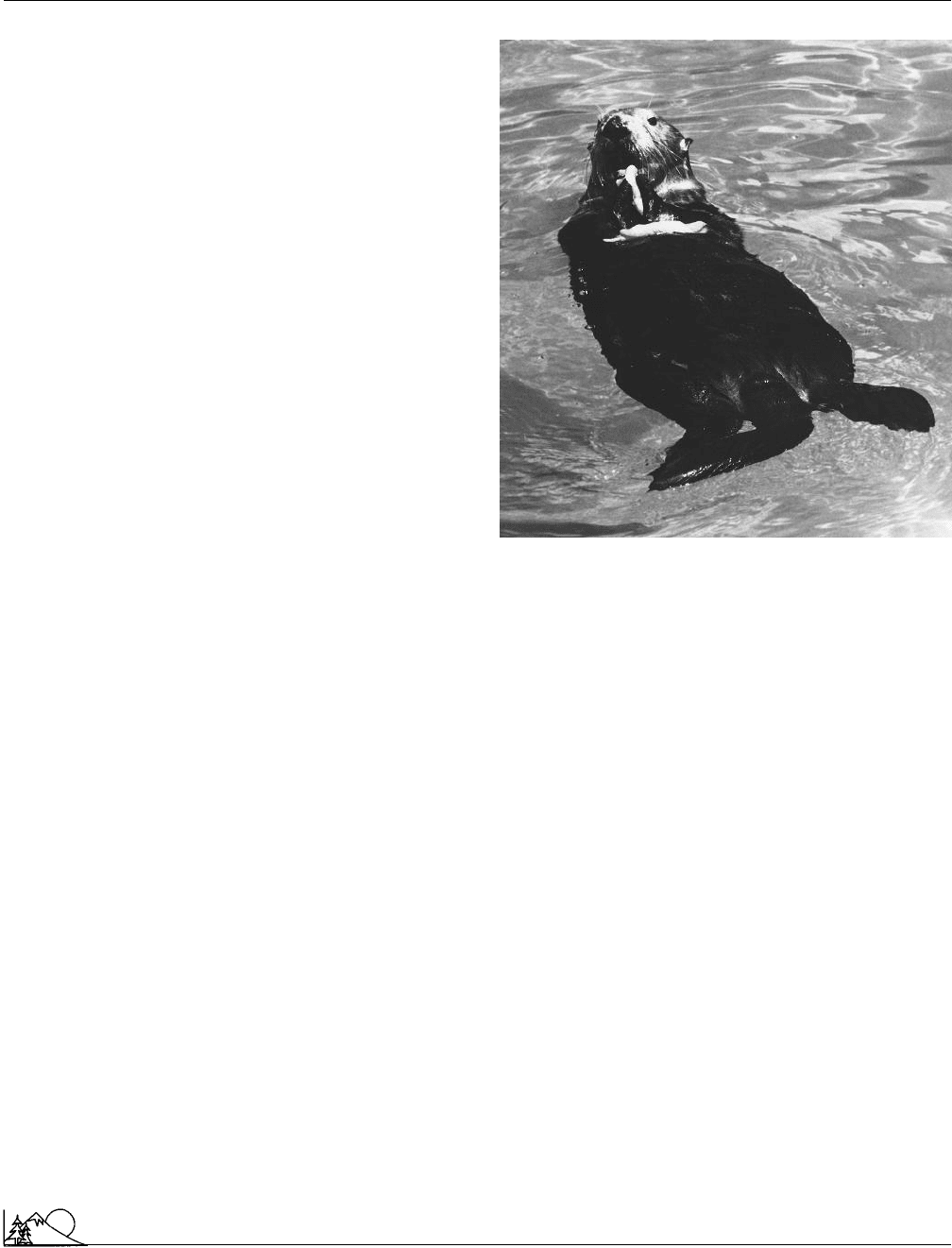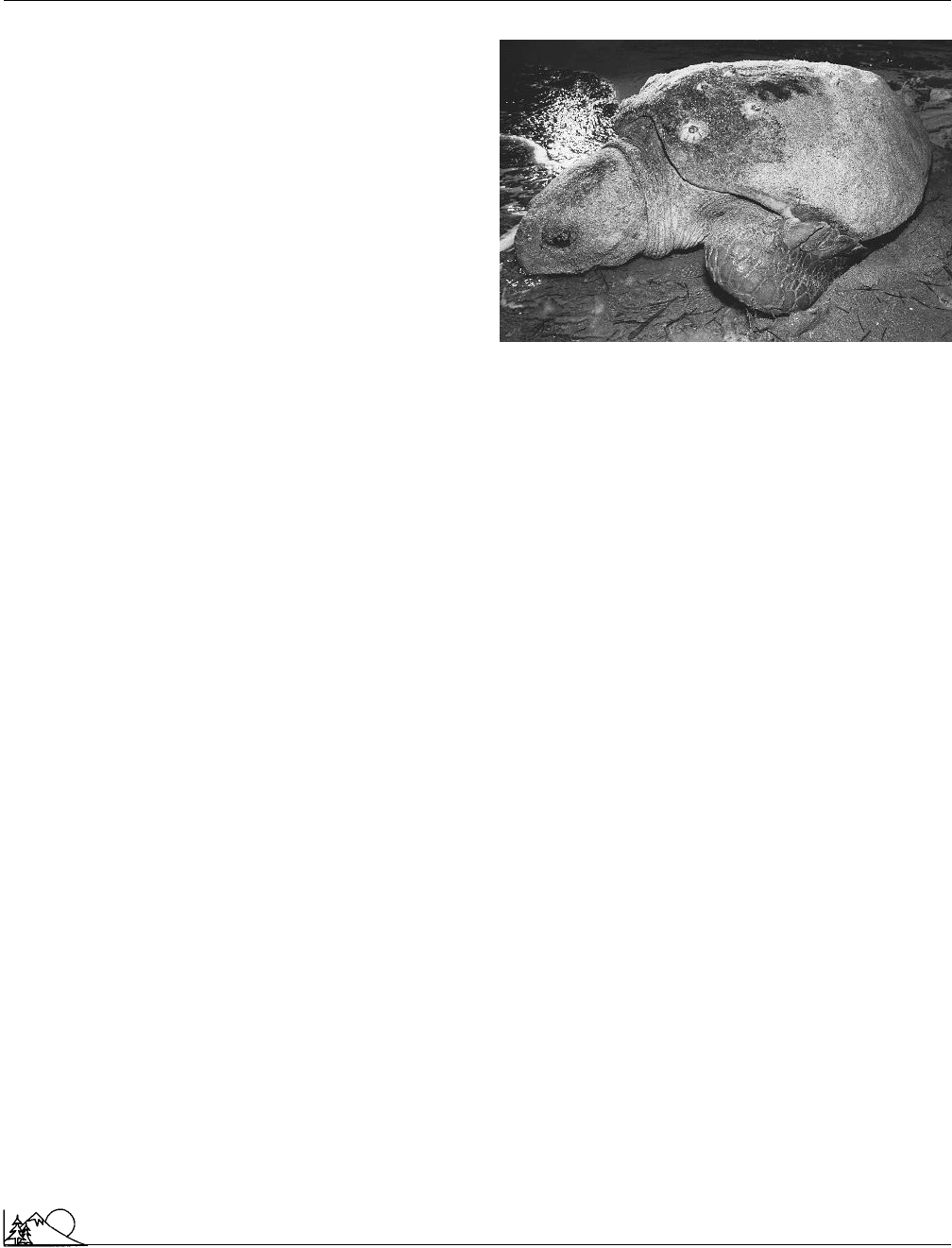Environmental Encyclopedia
Подождите немного. Документ загружается.


Environmental Encyclopedia 3
Scientific Committee on Problems of the Environment
In his A Guide For the Perplexed (1977), published in
1977, Schumacher is even more philosophical. He attempts
to provide personal rather than global guidance, encouraging
self-awareness and urging individuals to embrace what he
termed a “new age” ethic based on Judeo-Christian princi-
ples. He also wrote various pamphlets, including: Clean Air
and Future Energy, Think About Land, and Education for the
Future.
Schumacher died in 1977 while traveling in Switzer-
land from Lausanne to Zurich.
[Kimberley A. Peterson]
R
ESOURCES
B
OOKS
Schumacher, E. F. A Guide for the Perplexed. New York: Harper &
Row, 1977.
———. Small is Beautiful: Economics As If People Mattered. London: Blond
and Briggs, 1973.
P
ERIODICALS
Fraker, S., and G. C. Lubenow. “Mr. Small.” Newsweek (March 28,
1977): 18.
“Why It Is Important to Think Small.” International Management (August
1977): 18–20.
Albert Schweitzer (1875 – 1965)
German theologian, musicologist, philosopher, and phy-
sician
Albert Schweitzer was an individual of remarkable depth
and diversity. He was born in the Upper Alsace region of
what is now Germany. His parents, Louis (an Evangelical
Lutheran pastor and musician) and Adele cultivated his in-
quisitive mind and passion for music. He developed a strong
theological background and, under his father’s tutelage, stud-
ied piano, eventually acting as substitute musician at the
church.
As a young adult, Schweitzer pursued extensive studies
in philosophy and theology at the University of Strasbourg,
where he received doctorate degrees in both fields (1899
and 1900 respectively). He continued to further his interests
in music. While on a fellowship in Paris (researching Kant),
he also studied organ at the Sorbonne. He began a career
as an organist in 1893 and was eventually renowned as expert
in the area of organ construction and as one of the finest
interpreters and scholars of Johann Sebastian Bach. His
multitudinous published works include the respected J. S.
Bach: the Musician Poet (1908).
In 1905, after years of pursuing various careers—in-
cluding minister, musician, and teacher—he determined to
dedicate his work to the benefit of others. In 1913 he and his
wife, Helene, traveled to Lambarene in French Equatorial
1257
Africa (now Gabon), where they built a hospital on the
Ogowe River. At the outbreak of World War I, they were
allowed to continue working at the hospital for a time but
were then sent to France as prisoners of war (both were
German citizens). They were held in an internment camp
until 1918. After their release, the Schweitzers remained in
France and Albert returned to the pulpit. He also gave organ
concerts and lectures. During this time in France he wrote
“Philosophy of Civilization” (1923), an essay in which he
described his philosophy of “reverence for life.” Schweitzer
felt that it was the responsibility of all people to “sacrifice
a portion of their own lives for others.” The Schweitzers
returned to Africa in 1924, only to find their hospital over-
grown with jungle vegetation. With the assistance of volun-
teers, the facility was rebuilt, using typical African villages
as models.
Awarded the Nobel Peace Prize in 1952, Schweitzer
used $33,000 of the Prize money to establish a leper colony
near the hospital in Africa. It was not until late 1954 that
he gave his Nobel lecture in Oslo. He took advantage of
the opportunity to object to war as “a crime of inhumanity.”
Three more years passed before Schweitzer sent out an im-
passioned plea to the world in his “Declaration of Con-
science,” which he read over Oslo radio. He called for citizens
to demand a ban of
nuclear weapons
testing by their
governments. His words ignited a series of arms control talks
among the superpowers that began in 1958 and, five years
later, resulted in a limited but formal test-ban treaty.
Schweitzer received numerous awards and degrees.
Among his long list of published works are The Quest of the
Historical Jesus (1906), The Mysticism of Paul the Apostle
(1931), Out of My Life and Thought (1933, autobiography),
and The Light Within Us (1959). He died at the age of 90
at Lambarene.
[Kimberley A. Peterson]
R
ESOURCES
B
OOKS
Bentley, J. Albert Schweitzer: The Enigma. New York: Harper Collins, 1992.
Miller, D. C. Relevance of Albert Schweitzer at the Dawn of the Twenty-
First Century. Lanham: University Press of America, 1992.
Schweitzer, A. Out of My Life and Thought. New York: Henry Holt, 1990.
P
ERIODICALS
Negri, M. “The Humanism of Albert Schweitzer.” Humanist 53 (March–
April 1993): 26–31.
Scientific Committee on Problems of
the Environment
The Scientific Committee on Problems of the Environment

Environmental Encyclopedia 3
Scientists’ Institute for Public Information
(SCOPE) is a worldwide group of 22 international science
unions and 40 national committees that work together on
issues pertaining to the environment. SCOPE was founded
in 1969 and today is headquartered in Paris, France. SCOPE
stands as a permanent committee of the International Coun-
cil for Science.
SCOPE describes its organization as “an interdisci-
plinary body of natural and social science expertise focused
on global environmental issues, operating at the interface
between scientific and decision-making instances” and “a
worldwide network of scientists and scientific institutions
developing syntheses and reviews of scientific knowledge on
current or potential environmental issues.” The committee
aims to determine not only how human activities impact the
environment, but also how environmental changes impact
people’s health and welfare.
With its broad international nature, SCOPE acts as
an independent source of information for governments and
nongovernmental entities around the world by offering re-
search and consulting expertise on environmental topics. In
past years, the committee has gathered scientists to produce
reports including possible effects of nuclear war,
biosphere
programs to keep the earth inhabitable, and
radioactive
waste
.
SCOPE’s scientific program focuses on three main
areas: managing societal and
natural resources
,
ecosystem
processes and
biodiversity
, and health and the environment.
Managing societal and natural resources involves those proj-
ects that are founded on scientific research but that can be
applied in a practical manner to help sustain the biosphere.
In other words, the committee wants to ensure that Earth
can continue to produce the fuel, food, and other natural
resources needed to support the population. As of early 2002,
nearly a dozen projects involving biosphere development,
urban
waste management
, agriculture,
conservation
, and
others fell under the spectrum of this SCOPE task.
Ecosystem processes and biodiversity projects focus
on how ecosystems interact with human activities. These
projects look at how activities such as mining and movement
of substances such as
nitrogen
in rivers will affect the earth’s
land and water. Projects also look at changes in Earth’s
climate
and the impact that those changes may have on
future
ecology
.
The committee’s health and environment projects de-
velop methods to assess chemical risks of various activities
to humans, plants, animals, and habitats. For example, the
committee is working on a project involving the study of
effects of
mercury
, particularly in aquatic environments.
Another major project studies
radioactivity
at nuclear sites.
Called RADSITE, the project aims to review radioactive
wastes generated in development of
nuclear weapons
.
1258
In addition to its own work and affiliation with the
International Council for Science, SCOPE works in partner-
ship with several international bodies including the United
Nations Education, Social and Culture Organization (UN-
ESCO), and the International Human Dimensions Program
on Global Environmental Change (IHDP). SCOPE is a
unique organization in its international scientific approach
to, and cooperation on, environmental issues.
[Teresa G. Norris]
R
ESOURCES
P
ERIODICALS
O’Riordan, T. “A New Science for a New Age; New Scientist 133 (January
25, 1992): 14.
O
RGANIZATIONS
Scientific Committee on Problems of the Environment (SCOPE), %1,
blvd. De Montmorency F-75016, Paris, France 33-1-45250498, Fax: 33-
1-42881466, Email: secretariat@icsu-scope-org, <http://www.icsu-
scope.org>
Scientists’ Institute for Public
Information
Working to bridge a gap they perceive between scientists
and the media, the Scientists’ Institute for Public Informa-
tion (SIPI) was established in 1963 to disseminate expert
information on science and technology to journalists through
a variety of means.
SIPI’s best-known program is the Media Resource
Service (MRS), which was founded in 1980. The MRS
serves as a referral service for journalists seeking information
from scientists, engineers, physicians, and policymakers. The
MRS maintains a database listing more than 30,000 experts
who are available for and willing to comment on a variety
of topics. The service is free to any media outlet. The honor-
ary chair of the MRS advisory committee is the highly
regarded newscaster Walter Cronkite. The MRS is funded
by such noteworthy news organizations as CBS Inc., the
Scripps Howard Foundation, Time Warner, The Washing-
ton Post Company, the Associated Press, the National
Broadcasting Company, and The New York Times Com-
pany Foundation.
In addition to the MRS, SIPI operates the Videotape
Referral Service (VRS), another free resource service which
aids broadcast journalists in finding videotapes to accompany
science- and technology-related stories. The VRS also pro-
vides a list of videotapes for an annual SIPI conference called
“TV News: The Cutting Edge,” a meeting of scientists,
television news directors, and science reporters. The VRS
also publishes a monthly newsletter featuring topical listings

Environmental Encyclopedia 3
Scrubbers
of story ideas and a current catalogue of available videotapes
on science-related issues.
An outgrowth of the MRS, SIPI also operates the
International Hot Line in connection with its Global
Change program. The hotline provides assistance to journal-
ists worldwide by referring them to scientists and environ-
mental experts. The Global Change program holds briefings
to update the media on current international scientific and
environmental issues as well.
SIPI also organizes roundtable discussions, seminars,
and symposia for scientists and national journalists. These
programs have focused on such issues as nuclear waste dis-
posal, military technology and budget priorities, and human
gene therapy. SIPI has also developed smaller-scale versions
of these programs for state and regional press associations
and journalism schools.
In addition, SIPI sponsors the Defense Writers
Group. This group is made up of members of the Pentagon
press corps who gather to discuss views with defense experts.
In addition, SIPI publishes a newsletter addressing current
issues in science policy and featuring reviews of media cover-
age of science and technology.
[Kristin Palm]
SCOPE
see
Scientists’ Committee on Problems of
the Environment
Scotch broom
Scotch broom (Cytisus scoparius) is a member of the pea
family that is native to southern Europe and northern Africa.
It can grow up to 10 ft (3 m) in height. Scotch broom’s
yellow flowers are shaped like peas, and its leaves each have
three leaflets.
During the 1800s, Scotch broom was introduced into
the United States as an ornamental plant. In addition, people
used the plant for sweeping and make beer and tea with the
seeds. During the mid-1800s, Scotch broom was planted in
the western United States to stabilize roads and prevent
soil
erosion
. By the end of the twentieth century, the nonnative
plant was classified as an invasive weed in the Pacific North-
west and in parts of the northeastern United States and
southeastern Canada.
Scotch broom is a hearty plant that grows quickly. Its
seeds can last 80 years. Thick fields of Scotch broom can
crowd out vegetation that is native to an area. Spread of the
plant can reduce the amount of grazing
habitat
for animals.
Broom can block pathways used by
wildlife
. In addition,
broom can be a fire hazard.
1259
Methods of controlling the spread of Scotch broom
include removing the plant by its roots, spraying
herbicide
,
and controlled burning to destroy seeds.
[Liz Swain]
Scrubbers
Scrubbers are
air pollution control
devices that help cleanse
the emissions coming out of an incinerator’s
smoke
stack.
Hot exhaust gas comes out of the incinerator duct and
scrubbers help to wash the
particulate
matter (dust) re-
sulting from the
combustion
out of the gas. High efficiency
scrubbers literally scrub the smoke by mixing dust particles
and droplets of water (as fine as mist) together at a very
high speed. Scrubbers force the dust to move like a bullet
fired at high velocity into the water droplet. The process is
similar to the way that rain washes the air.
Scrubbers can also be used as absorbers.
Absorption
dissolves material into a liquid, much as sugar is absorbed
into coffee. From an
air pollution
standpoint, absorption
is a useful method of reducing or eliminating the
discharge
of air contaminants into the
atmosphere
. The gaseous air
contaminants most commonly controlled by absorption in-
clude
sulfur dioxide
,
hydrogen
sulfide, hydrogen chloride,
chlorine
, ammonia,
nitrogen oxides
, and light
hydro-
carbons
.
Gas absorption equipment is designed to provide thor-
ough contact between the gas and liquid solvent in order to
permit interphase diffusion and solution of the materials.
This contact between gas and liquid can be accomplished
by dispersing gas in liquid and visa versa. Scrubbers help
wash out polluting
chemicals
from the exhaust gas by facili-
tating the mixture of liquid (solvent) and gas together.
A number of engineering designs serve to disperse
liquid. These include a packed tower, a spray tower or spray
chamber, venturi absorbers, and a bubble tray tower.
The most appropriate design for
incineration
facilities
is the packed tower—a tower filled with one of many avail-
able packing materials. The packing material should provide
a large surface area and, for good fluid flow, should be shaped
to give large void space when packed. It should also be
chemically inert and inexpensive. It must be designed so as
to expose a large surface area and be made of materials, such
as stainless steel, ceramic or certain forms of plastic.
Packing materials come in various manufactured
shapes. They may look like a saddle, a thick tube, a many-
faceted star, a scouring pad, or a cylinder with a number of
holes carved in it. Packing may be dumped into the column
at random or stacked in some kind of order. Randomly
dumped packing has a higher gas pressure drop across the
bed. The stacked packings have an advantage of lower pres-

Environmental Encyclopedia 3
Sea level change
sure and higher possible liquid throughout, but the installa-
tion cost is much higher because they are packed by hand.
Rock and gravel have also been used as packing materi-
als but are usually considered too heavy. They also have
small surface areas, give poor fluid flow and at times are not
chemically inert.
The liquid is introduced at the top of the tower and
trickles down through to the bottom. Since the effectiveness
of a packed tower depends on the availability of a large,
exposed liquid film, poor liquid distribution that prevents a
portion of the packing from being irrigated renders that
portion of the tower ineffective. Poor distribution can result
from improper introduction of the liquid at the top of the
tower or using the wrong rate of liquid flow. The liquid rate
must be sufficient to wet the packing but not flood the
tower. A liquid rate of at least 800 pounds of liquid per
hour per square foot of tower cross-section is typical.
While the liquid introduced at the top of the tower
trickles down through the packing, the gas is introduced at
the bottom and passes upward through the packing. This
process results in the highest possible efficiency. Where the
gas stream and solvent enter at the top of the column, there
is initially a very high rate of absorption that constantly
decreases until the gas and liquid exit in equilibrium.
Scrubbers are used in
coal
burning industries that
generate electricity. They can be used in high sulfur coal
emissions because high sulfur coal emits high levels of sulfur
dioxide. Scrubbers are also utilized in industrial chemical
manufacturing as an important operation in the production
of a chemical compound. For example, one step in the manu-
facture of hydrochloric
acid
involves the absorption of hy-
drochloric acid gas in water. Scrubbers are used as a method
of recovering valuable products from gas streams—as in
petroleum
production where natural
gasoline
is removed
from gas streams by absorption in a special hydrocarbon oil.
See also Air pollution; Flue-gas scrubbing; Tall stacks
[Liane Clorfene Casten]
R
ESOURCES
B
OOKS
Schiffner, K. C. Wet Scrubbers. Chelsea, MI: Lewis, 1986.
P
ERIODICALS
“Fume Scrubbers Benefit Environment and Manufacturing.” Design News
48 (August 24, 1992): 28–9.
“Scrubbing Emissions.” Environment 31 (March 1989): 22.
Sea cows
see
Manatees
1260
Sea level change
For at least tens of thousands of years, changes in sea level
seem to be a natural part of the earth’s
environment
.Up
until a few hundred years ago, these changes, both up and
down, occurred due to land movement, ice melting from
glaciers, and an increase or decrease in the amount of water
trapped in the polar ice caps. In most cases, the changes
were very gradual in human terms. But in the past several
decades, many scientists have become alarmed at the rapid
increase in ocean levels.
The reason is because the earth is heating up, which
causes sea water to expand in volume and ice caps to melt.
Over the past 100 years, scientists have measured a mean
sea level rise of about 4 in (10 cm). They blame it on
an average increase of 1.8°F (1°C) in world-wide surface
temperatures of the planet. With the advent of satellites and
other technology in the last half of the twentieth century,
scientists have been able to more precisely measure the ocean
levels. They have found that sea levels are rising at a rate of
about 0.4–1.2 in (1–2 cm) per year. A 1-ft (30-cm) rise in
sea level would place at least 100 ft (30 m) of beach width
underwater.
Why the earth is heating up is the subject of much
discussion and disagreement among scientists. Some believe
it is due to the heavy burning of
fossil fuels
, such as
coal
and oil, which causes increases the amounts of certain gases,
particularly
carbon dioxide
,inthe
atmosphere
. Other
scientists believe the current global warming is mostly a
natural phenomenon and a part of the normal cycle of the
planet’s environment.
Scientists are studying the ice cap on
Antarctica
to
determine if, in fact, the earth’s
climate
is warming due to
the burning of fossil fuels. The global warming hypothesis is
based on the atmospheric process known as the
greenhouse
effect
, in which
pollution
prevents the heat energy of the
earth from escaping into the outer atmosphere. Global
warming could cause some of the ice caps to melt, raising
the sea level and
flooding
many of the world’s largest cities,
including New York, Los Angeles, Tokyo, and London, and
other lowland areas. Nearly half of the world’s population
live in coastal areas. Because the polar regions are the engines
that drive the world’s weather system, this research is essen-
tial to identify the effect of human activity on these regions.
Many scientists are concerned about the increasing
levels of
carbon
dioxide in Earth’s atmosphere. With more
carbon dioxide in the atmosphere, they say, more heat will
be trapped. Earth’s annual average temperature will begin to
rise. Some estimates suggest that a doubling of atmospheric
carbon dioxide will result in an increase of 4.5°F (2.5°C) in
the planet’s annual average temperature.

Environmental Encyclopedia 3
Sea otter
While that number may seem small, it could have
disastrous effects on the world’s economies. One result might
be the melting of Earth’s ice caps at the North and South
poles, with a resulting increase in the volume of the ocean’s
water. Were that to happen, many of the world’s largest
cities, those located along the edge of the oceans, might be
flooded. Some experts predict dramatic changes in climate
that could turn currently productive croplands into deserts,
and deserts into productive agricultural regions.
As with many environmental issues, experts tend to
disagree about one or more aspects of anticipated climate
change. Some authorities are not convinced that the addition
of carbon dioxide to the atmosphere will have any significant
long-term effects on Earth’s average annual temperature.
Others concede that Earth’s temperature may increase, but
that the changes predicted are unlikely to occur. They point
out that other factors, such as the formation of clouds, might
counteract the presence of additional carbon dioxide in the
atmosphere. They warn that nations should not act too
quickly to reduce the
combustion
of fossil fuels since that
will cause serious economic problems in many parts of the
world. They suggest it would be prudent to wait for a while
to see if greenhouse factors really are beginning to change.
[Ken R. Wells]
R
ESOURCES
B
OOKS
Douglas, B. C. ed, et al. Sea Level Rise: History and Consequences. San
Diego: Academic Press, 2000.
P
ERIODICALS
Laber, Emily. “Meltdown.” The Sciences (July 1999): 6.
Middleton, Nick. “The Heat is On.” Geographical (January 2000): 44.
Moore, Curtis A. “Awash in a Rising Sea.”International Wildlife (January–
February 2002).
Spalding, Mark. “Danger on the High Seas.” Geographical (February 2002):
15–16.
Foley, Grover. “The Threat of Rising Seas.” The Ecologist (March–April
1999): 76–79.
O
RGANIZATIONS
National Oceanic and Atmospheric Administration, 14th St. and
Constitution Ave. NW, Room 6013, Washington, DC USA 20230
(202)482-6090, Fax: (202)482-3154, Email: answers@noaa.gov, <http://
www.noaa.gov>
Sea lions
see
Seals and sea lions
Sea otter
The sea otter (Enhydra lutris) is found in coastal marine
waters of the northeastern Pacific Ocean, ranging from Cali-
1261
A female sea otter eating squid. (Photograph by
Karl W. Kenyon, National Audubon Society Collection.
Photo Researchers Inc. Reproduced by permission.)
fornia to as far north as the Aleutian Islands. Sea otters
spend their entire lives in the ocean and even give birth
while floating among the kelp beds. Their ability to use
tools, often “favorite” rocks, to open clam shells and sea
urchins is well-known and fascinating since few other ani-
mals are known to exhibit this behavior. Their playful, curi-
ous nature makes them the subjects of many
wildlife
pho-
tographers but also has aided in their demise. Many are
injured or killed by ship propellers or in fishing nets.
Some sea otters are killed for their highly valued fur.
Their thick hair traps air, insulating the otter from the cold
water in which it lives. Before they were placed under inter-
national protection in 1924, 800,000 to one million sea otters
were slaughtered for their pelts, eliminating them from large
portions of their original range. Despite
poaching
, which
remains a problem, they are slowly returning through reloca-
tion efforts and natural
migration
. Their proximity to hu-
man settlement, however, still poses a problem for their
continued survival.
Pollution
, especially from
oil spills
, is deadly to the
sea otter. The insulating and water-repellant properties of
their fur are inhibited when oil causes the fine hairs to stick
together, and otters die from hypothermia. Ingestion of oil
during grooming does extensive, often fatal, internal damage.

Environmental Encyclopedia 3
Sea Shepherd Conservation Society
In 1965, an oil spill near Great Sitkin Island, Alaska, reduced
the island’s otter population from 600 to six. In 1989, the
oil tanker
Exxon Valdez
spilled over 11 million gal (40
million l) of crude oil into
Prince William Sound
, Alaska,
leading to the nearly complete elimination of the Sound’s
once thriving sea otter population. In California, fears that
a similar incident could destroy the sea otter population
there have led to relocation efforts.
Sea otters have few natural enemies, but they were
extensively hunted by Aleuts and later by Europeans. Sea
otters were hunted to
extinction
around several islands in
Alaska, an event that led to studies on the importance of
sea otters in maintaining marine communities. Attu Island,
one of the islands that has lost its otter population, has high
sea urchin populations that have, through their grazing,
transformed a kelp forest into a “bare” hard ground of
coralline and green algae. Few fish or abalone are present
in these waters anymore. On nearby Amchitka Island, otters
are present in densities of 7.7–11.6 per mi
2
(20–30 per km
2
)
and forage at depths up to 22 yd (20 m). In this area, few
sea urchins persist and dense kelp forests harbor healthy fish
and abalone populations. These in turn support higher-order
predators such as
seals
and bald eagles.
Effects of sea otter foraging have also been docu-
mented in soft-bottom communities, where they reduce den-
sities of sea urchins and clams. In addition, disturbance of
the bottom
sediment
leads to increased predation of small
bivalves by sea stars. Otters’ voracious appetite for inverte-
brates also brings them into conflict with people. Fishermen
in northern California blame sea otters for the decline of the
abalone industry. Farther south, residents of Pismo Beach, an
area noted for its clam industry, are exerting pressure to
remove otters. Sea urchin and crab fishermen have also come
into conflict with these competitors. It remains a challenge
for fishermen, environmentalists, and regulators to arrive
at a mutually agreeable management policy that will allow
successful coexistence with sea otters. The sea otter census
of 2001 counted only 2,161 otters in California, less than
6,000 in Alaska, 2,500 in Canada, 555 in Washington, and
about 15,000 in Russia. They are considered endangered by
the IUCN.
[William G. Ambrose Jr. and Paul E. Renaud]
R
ESOURCES
B
OOKS
Sumick, J. L. An Introduction to the Biology of Marine Life. 5th ed. Dubuque,
IA: W. C. Brown, 1992.
P
ERIODICALS
Brazil, Eric. “Annual Census Begins in State for Nearly Extinct Sea Mam-
mal. San Francisco Chronicle (May 18, 2001): A3.
Kvitek, R. G., et al. “Changes in the Alaskan Soft-Bottom Prey Communi-
ties Along a Gradient of Sea Otter Predation.” Ecology 73 (1992): 413–28.
1262
“Northern Sea Otters may be Declared Endangered.” The Grand Rapids
Press (November 12, 2000): A3.
Raloff, J. “An Otter Tragedy.” Science News 143 (1993): 200–202.
O
THER
Help Save the Sea Otters. [cited May 2002]. <http://www.saveseaotters.org>.
Friends of the Sea Otter. [cited May 2002]. <http://www.seaotters.org>.
Sea Shepherd Conservation Society
The Sea Shepherd Conservation Society was founded in
1977 by Paul Watson, one of the founding members of
Greenpeace
, as an aggressive direct action organization
dedicated to the international conservation and protection
of marine
wildlife
in general and marine mammals in partic-
ular. The society seeks to combat exploitative practices
through education, confrontation, and the enforcement of
existing laws, statutes, treaties, and regulations. It maintains
offices in the United States, Great Britain, and Canada, and
has an international membership of about 15,000.
Sea Shepherd regards itself virtually as a police force
dedicated to ocean and marine life conservation. Most of
its attention over the years has been devoted to the enforce-
ment of the regulations of the International Whaling Com-
mission (IWC), which makes policies for signatory states
on
whaling
practices but does not itself have powers of
enforcement. The stated objective of the society has been
to harass, interfere with, and ultimately shut down all contin-
uing illegal whaling activities.
Called a “samurai conservation organization” by the
Japanese media, Sea Shepherd often walks a thin line be-
tween legal and illegal tactics. The society operates two
research ships, the Sea Shepherd and the Edward Abbey, and
has been known to ram illegal or pirate whaling ships and
to sabotage whale processing operations. All crew members
are trained in techniques of “creative non-violence:” They
are forbidden to carry weapons or explosives or to endanger
human life and are enjoined to accept all moral responsibility
and legal consequences for their actions.
Crew members also pledge never to compromise on
the lives of the marine mammals they protect. The Society
has documented on film illegal whaling operations in the
former Soviet Union and presented this evidence to the
IWC, despite being chased back to United States waters by
a Soviet frigate and helicopter gunships. Moreover, members
are not at all squeamish about the destruction of weapons,
ships, and other property used in the slaughter of marine
wildlife. In 1979, Sea Shepherd hunted down and rammed
the pirate whaler Sierra, eventually putting it out of business.
Publicity over the Sierra operation motivated the arrest of
two other pirate whalers in South Africa. The next year Sea
Shepherd was involved in the sinking of two Spanish whalers

Environmental Encyclopedia 3
Sea turtles
that had flagrantly exceeded whale quotas set by the IWC.
In 1986, Sea Shepherd was involved in the sinking of two
Icelandic whalers (half the Icelandic whaling fleet) in Reyk-
javik harbor and also managed to damage the nearby whale-
processing plant. Seeking publicity, crew members de-
manded to be arrested for their actions, but Iceland refused
to charge them. Indeed, Sea Shepherd claims that in all of
its operations it has never caused nor suffered an injury, nor
have any of its crew members been convicted in criminal
proceedings.
Typically, Sea Shepherd invites members of the news
media along to document and publicize the destructive and
exploitative practices it opposes. Such documentary footage
has been shown on major television networks in the United
States, Britain, Canada,
Australia
, and Western Europe.
This publicity played an important role in increasing public
awareness of marine conservation issues and in mobilizing
public opinion against the slaughter of marine mammals.
Sea Shepherd helped to bring about the end of commercial
seal-killing in Canada and in the Orkney Islands, Scotland.
Highly successful in its efforts against outlaw whalers,
Sea Shepherd continues to conduct research on conservation
and
pollution
issues and to monitor national and interna-
tional law on marine conservation issues. Its members are
working to establish a wildlife sanctuary in the Orkney
Islands. Its present campaign is focused primarily against drift
netfishing in the NorthPacific, in support ofa United Nations
call for a complete international ban on drift-net fishing.
[Lawrence J. Biskowski]
R
ESOURCES
O
RGANIZATIONS
Sea Shepherd Conservation Society, 22774 Pacific Coast Hwy., Malibu,
CA USA 90265 (310) 456-1141, Toll Free: (310) 456-2488, <http://
www.seashepherd.com>
Sea turtles
Sea turtle populations have dramatically declined in numbers
over the past half century. Green sea turtles (Chelonia mydas),
hawksbills (Eretmochelys imbricata), Kemp’s Ridleys (Lepido-
chelys kempii), loggerheads (Caretta caretta), and leatherbacks
(Dermochelys coriacea) have all had their numbers decimated
by human activity. The decline has been caused by several
factors, including the development of a highly industrialized
fishery to meet the demand for seafood on a worldwide
basis. The most economical fishing method involves pulling
multiple nets underwater for extended periods of time, and
any air-breathing animals, such as sea turtles, which get
caught in the net are usually drowned before they are hoisted
on board.
1263
Loggerhead sea turtle returns to sea after lay-
ing eggs on a Florida beach. (Corbis-Bettmann. Re-
produced by permission.)
In the United States, this problem has led to the
introduction of the
turtle excluder device
(TED), which
must be placed on each tow net used by commercial shrimp-
ers and fishermen. These cage-like devices have a slanted
section of bars which allow fish and shellfish into the net
but deflect turtles. These highly controversial devices have
been mandatory for less than a decade, but there are some
indications that they are saving thousands of turtles per year.
As significant as the impact of
commercial fishing
may seem, it does little to sea turtle populations compared
to losses incurred at the earliest stages of the turtles’ life
history. In the late 1940s, along an isolated beach near
Tamaulipas, Mexico, an extremely dense assemblage of sea
turtles were observed digging out nests and laying eggs at
the beach. So many females were present that they were
seen crawling over one another and digging out the nests
of others in order to lay their own eggs. At this location
alone, the sea turtle population was estimated in the millions.
In the early 1960s, scientists realized that the turtles found
at Tamaulipas were a distinct
species
, Kemp’s Ridley, and
that they nested nowhere else in the world; but by that time
the population had declined to only a few hundred turtles.
Threats to the survival of newly hatched sea turtles
have always been enormous; crows, gulls, and other predators
attack them as they scurry seaward, and they are prey for
waiting barracudas and jacks as they reach water. Other
animals raid their nests for the eggs, and humans are among
these nest predators, collecting the eggs for food. Sea turtles
concentrate their numbers in small nesting locations such
as Tamaulipas in order to greatly outnumber their natural
predators, thus allowing for the survival of at least a few
individuals to perpetuate the species. However, this congre-

Environmental Encyclopedia 3
Seabed disposal
A green sea turtle. (Photograph by Dr. Paula A. Zahl.
Photo Researchers Inc. Reproduced by permission.)
gating behavior has contributed to their demise, because it
has made human predation easier and more profitable.
Adult turtles are harvested as a protein source in many
Third World
countries, and many turtles are also subjected
to increasing levels of
marine pollution
. Both of these fac-
tors have contributed to the sharp decline in their population.
Public awareness and
conservation
efforts may keep sea
turtles from
extinction
, but it is not clear whether species
will be capable of rebounding from the decimation that has
already taken place.
[Eugene C. Beckham]
R
ESOURCES
B
OOKS
Bjorndal, K. A., ed. Biology and Conservation of Sea Turtles. Washington,
D.C.: Smithsonian Institution Press, 1981.
Carr, Archie. So Excellent a Fish: Tales of Sea Turtles. New York: Scribn-
ers, 1984.
National Research Council. Decline of the Sea Turtles: Causes and Prevention.
Washington, DC: National Academy Press, 1990.
P
ERIODICALS
Ezell, C. “Turtle Recovery Could Take Many Decades.” Science News 142
(August 22, 1992): 118.
“Sea Turtle Nesting Begins Soon.” The Florida Times Union (April 13,
2002): L–13.
1264
Stolzenburg, W. “Requiem for the Ancient Mariner.” Sea Frontiers 39
(March–April 1993): 16–18.
O
THER
National Marine Fisheries Service. [cited May 2002]. <http://
www.nmfs.noaa.gov>.
Seabed disposal
Over 70% of the earth’s surface is covered by water. The
coastal zone—the boundary between the ocean and land—
is under the primary influence of humans, while the rest of
the ocean remains fairly remote from human activity. This
remoteness has in part led scientists and policy makers to
examine the deep ocean, particularly the seabed, as a poten-
tial location for waste disposal.
Much of the deep ocean seabed consists of abyssal
hills and vast plains that are geologically stable and have
sparse numbers of bottom-dwelling organisms. These areas
have been characterized as oozes, hundreds of meters thick,
that are in effect “deserts” in the sea. Other attributes of the
deep ocean seabed that have led scientists and policy makers
to consider the sea bottom as a repository for waste include
the immobility of the interstitial pore water within the
sedi-
ment
, and the tendency for ions to adsorb or stick to the
sediment, which limits movement of elements within the
waste. Another important factor has been the lack of known
commercial resources such as
hydrocarbons
, minerals, or
fisheries.
The deep seabed has been studied as a potential dis-
posal option specifically for the placement of
high-level
radioactive waste
. Investigations on the feasibility of dis-
posing radioactive wastes in the seabed were carried out for
over a decade by a host of scientists from around the world.
In 1976, the Organization for Economic Cooperation and
Development (OECD) and the Nuclear Energy Agency
coordinated research at the international level and formed
the Seabed Working Group. Members of the group included
Belgium, Canada, France, the Federal Republic of Germany,
Italy, Japan, the Netherlands, Switzerland, United Kingdom,
United States, and the Commission of European Communi-
ties. The Seabed Working Group focused its investigation
on two sites in the Atlantic Ocean, Great Meteor East and
the Southern Nares Abyssal Plain, and one site in the Pacific
Ocean, known as E2. The Great Meteor East site lies be-
tween 30.5°N and 32.5°N, 23°W and 26°W, approximately
1,865 mi (3,000 km) southwest of Britain. The Southern
Nares Abyssal Plain site lies between 22.58°N and 23.17°N,
63.25°W and 63.67°W, approximately 375 mi (600 km)
north of Puerto Rico. Site E2 in the Pacific Ocean lies
between 31.3°N and 32.67°N, 163.42°E and 165°E, and is
approximately 1,240 mi (2,000 km) east of Japan.

Environmental Encyclopedia 3
Seabed disposal
This working group pursued a multidisciplinary ap-
proach to studying the deep-ocean sediments as a potential
disposal option for high-level
radioactive waste
. High-
level radioactive waste consists of spent nuclear fuel or by-
products from the reprocessing of spent nuclear fuel. It also
includes transuranic wastes, a byproduct of fuel assembly,
weapons fabrications, and reprocessing operations, and
ura-
nium
mill
tailings
, a byproduct of mining operations.
Low-
level radioactive waste
is legally defined as all types of
waste that do not fall into the high-level radioactive waste
category. They are made up primarily of byproducts of nu-
clear reactor operations and products that have been in con-
tact with the use of radioisotopes. Low-level radioactive
wastes are characterized as having small amounts of
radioac-
tivity
that do not usually require shielding or heat-removing
equipment.
One proposal to dispose of high-level radioactive waste
in the deep seabed involved the enclosure of the waste in
an insoluble solid with metal sheathing or projectile-shaped
canisters. When dropped overboard from a ship, the canisters
would fall freely to the ocean bottom and bury themselves
33–44 yd (30–40 m) into the soft sediments of the seabed.
Other proposals recommend drilling holes in the seabed and
mechanically inserting the canisters. After emplacement of
the canisters, the holes would then be plugged with inert
material.
The 1972 international
Convention on the Preven-
tion of Marine Pollution by Dumping of Waste and Other
Matter
, commonly called the London Dumping Conven-
tion, prohibits the disposal of high-level radioactive wastes.
In the United States, the
Marine Protection, Research and
Sanctuaries Act
of 1972 also bans the ocean disposal of
high-level radioactive waste. However, Britain has recently
considered using the continental shelf seabed for disposal of
low- and intermediate-level radioactive waste. The Euro-
pean countries discontinued
ocean dumping
of low-level
radioactive waste in 1982. In the United States, the ocean
disposal of low-level radioactive waste ceased in the 1970s.
Between 1951 and 1967, approximately 34,000 containers
of low-level radioactive waste were dumped in the Atlantic
Ocean by the United States.
Another important aspect in the debate about seabed
disposal is the risk to humans, not only because of the
potential for direct contact with wastes but also because of
the possibility of accidents during transport to the disposal
location and contamination of fishery resources. When com-
paring seabed disposal of high-level radioactive waste to
land disposal, for example, the
transportation
risks may be
higher because travel to a site at sea would likely be longer
than travel to a location on land. Increased handling by
personnel substantially increases the risk. Also, there is a
statistically greater risk of accidents at sea than on land
1265
when transporting anything, especially radioactive wastes,
although such an accident at sea would probably pose less
risk to humans.
It is also a concern that the seabed
environment
may
be more inhospitable than a land site to the metal canisters
containing the radioactive waste, because corrosion is more
rapid due to the salts in marine systems. In addition, it is
uncertain how fast
radionuclides
will be transported away
from the site. The heat associated with the decay of high-
level radioactive waste may cause convection in the sediment
pore waters, resulting in the possibility that the dissolved
radioactive material will diffuse to the sediment-water inter-
face. Predictions from calculations, however, indicate that
convection may not be significant. According to laboratory
experiments that simulate subseabed conditions, it would
take roughly 1,000 years for radioactive waste buried at a
depth of 33 yd (30 m) to reach the sediment-water interface.
Other technical considerations adding to the uncertainty of
the ultimate fate of buried radioactive waste in the seabed
involve possible
sorption
of the radionuclide cations to clay
particles in the sediment, and possible uptake of radionu-
clides by bottom dwelling organisms.
The Seabed Working Group concluded from their
investigation that seabed disposal of high-level radioactive
waste is safe. Compared to land disposal sites, the predicted
doses of possible
radiation exposure
are lower than pub-
lished radiological assessments. However, there are political
concerns over deep-ocean seabed disposal of wastes. Deep-
ocean disposal sites would likely be in international waters.
Therefore, international agreements would have to be
reached, which may be very difficult with countries without
a
nuclear power
industry, particularly for disposal of radio-
active waste.
In 1991, the Woods Hole Oceanographic Institution
held a workshop to discuss the research required to assess
the potential of the abyssal ocean as an option for disposal
of sewage
sludge
, incinerator ash, and other high volume
benign wastes. The disposal technology considered at this
workshop entailed employing an enclosed elevator from a
ship to emplace the waste at or close to the seabed. One
issue raised at the workshop was the need to investigate the
incidence of benthic storms that may occur along the deep
ocean seabed. These benthic storms, also called turbidity
flows, are currents with high concentrations of sediment that
can stir up the sea bottom, erode the seabed, and redistribute
sediment further downstream.
Woods Hole held a follow-up workshop in 1992. In-
cluded were a broader array of scientists and representatives
from environmental organizations, and these two groups
disagreed over the use of the ocean floor as a waste-disposal
option. The researchers supported the consideration and
study of the seabed and the ocean in general as sites for

Environmental Encyclopedia 3
Seabrook Nuclear Reactor
disposal of wastes. The environmentalists did not support
ocean disposal of wastes. The environmentalists’ view is
consistent with the law passed in 1988, the
Ocean Dumping
Ban Act
, which prohibits the dumping of sewage sludge and
industrial waste in the marine environment. In 1993, a ban
on the dumping of any radioactive materials into the sea
was put into effect at the London Convention and will be
enforced until 2018. See also Convention on the Law of the
Sea; Dredging; Hazardous waste siting; Marine pollution;
Ocean dumping; Radioactive pollution
[Marci L. Bortman]
R
ESOURCES
B
OOKS
Chapman, N. A., and I. G. McKinley. The Geological Disposal of Nuclear
Waste. New York: Wiley, 1987.
Freeman, T. J., ed. Advances in Underwater Technology, Ocean Science and
Offshore Engineering. Vol. 18, Disposal of Radioactive Waste in Seabed Sedi-
ments. Boston: Graham & Trotman, 1989.
Krauskopf, K. B. Radioactive Waste Disposal and Geology. New York: Chap-
man and Hall, 1988.
Murray, R. L. Understanding Radioactive Waste. Ed. Judith A. Powell.
Columbus, OH: Battelle Press, 1989.
P
ERIODICALS
Spencer, D. W. “The Ocean and Waste Management.” Oceanus 33 (Summer
1990): 7–23.
Seabrook Nuclear Reactor
Americans once looked to nuclear energy as the nation’s
great hope for power generation in the twenty-first century.
Today, nuclear
power plants
are regarded with suspicion
and distrust, and new proposals to construct them are met
with opposition. Perhaps the best transition in the perception
of
nuclear power
is the debate that surrounded the con-
struction of the Seabrook Nuclear Reactor in Seabrook, New
Hampshire.
The plant was first proposed in 1969 by the Public
Service Company of New Hampshire (PSC), an agency then
responsible for providing 90% of all electrical power used in
that state. The PSC planned to construct a pair of atomic
reactors in marshlands near Seabrook in order to ensure an
adequate supply of electricity in the future.
Residents were not enthusiastic about the plan. The
marshlands and beaches around Seabrook have long been a
source of pride to the community, and in March of 1976,
the town voted to oppose the plant. Townspeople soon
received a great deal of support. Seabrook is only a few
miles north of the Massachusetts border, and residents and
1266
government officials from that state joined the opposition
against the proposed plant. In addition, an umbrella organi-
zation of 15 anti-nuclear groups called the Clamshell Alli-
ance was formed to fight the PSC plan.
The next 12 years were characterized by almost non-
stop confrontation between the PSC and its supporters and
Clamshell Alliance and other groups opposed to the proposal.
Hardly a month passed during the 1970s and 80s without
news of another demonstration or the arrest of someone pro-
testing construction. The issues became more complex as eco-
nomic and technical considerations changed during this time.
The demand for electricity, for example, began to drop instead
of increasing, as the PSC had predicted, and at least three
other utilities that had agreed to work with PSC on construc-
tion of the plant withdrew from the program. The total cost
of construction also continued to rise. When first designed,
construction costs were estimated at $973 million for both
reactors. Only one reactor was ever built, and by the time that
it was finally licensed in 1990, total expenditures for it alone
had reached nearly $6.5 billion.
The decision to build at Seabrook eventually proved
to be a disaster financially and from a public relations stance
for PSC. The company’s economic woes peaked in 1979
when the courts ruled that PSC could not pass along addi-
tional construction costs at Seabrook to its customers. Over
the next decade, the company fell into even more difficult
financial straits, and on January 28, 1988, it filed for bank-
ruptcy protection. The company promised that its action
was not the end for the Seabrook reactor and maintained
that the plant would eventually be licensed.
A little more than two years later, the
Nuclear Regu-
latory Commission
(NRC) granted a full-power operating
license to the Seabrook plant. The decision was received
enthusiastically by the utility companies in the New England
Power Pool, who believed that Seabrook’s additional capacity
would reduce the number of power shortages experienced
by consumers in the six-state region.
Private citizens and government officials were not as
enthusiastic. Consumers faced the prospect of higher electri-
cal bills to pay for Seabrook’s operating costs, and many
observers continued to worry about potential safety prob-
lems. Massachusetts attorney general, James Shannon, for
example, was quoted as saying that Seabrook received “the
most legally vulnerable license the NRC has ever issued.”
As of July 2002, Seabrook was operating at 100%
power and providing electricity for over one million homes.
See also Electric utilities; Energy policy; Nuclear fission;
Radioactive waste management; Three Mile Island Nuclear
Reactor
[David E. Newton]
